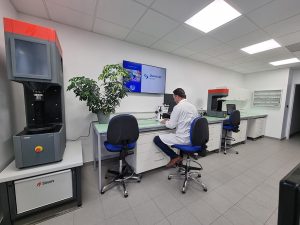07/10/2022 NEWS / PRESS
STAINLESS Group the new central metallurgy laboratory

STAINLESS Group has taken a new step by opening a new 40 m2 expertise laboratory at its headquarters, with a range of equipment including metallurgical analysis. . The equipment includes an OES spectrometer, polishing machines, hardness testing machines, a laser micrometer, an oven and an optical microscope.
The investment of about 250K€ is intended to support customers in technical expertise, new product development or material validation, for example.
Thanks to its knowledge and proximity to major material producers and over 90 years of technical expertise, STAINLESS Group can offer its customers and prospects standard or customized training courses provided by the group’s technical director and doctor of metallurgy, Thierry Turpin.
These training courses are perfectly adapted to the expectations of industrialists and addressed to a large variety of audiences, including non-experts, buyers, design offices and R&D departments.
The new central metallurgy laboratory is equipped with several inspection tools, including:
- A ZUMBACH laser micrometer to check the diameter and ovality of a bar in order to meet the ever-tighter requirements,
- A binocular magnifying glass which allows to zoom between x1 and x5 in order to observe for example the fracture surfaces,
- An OES spectrometer to check the chemical composition of a product down to a few ppm. The sparks produced during the test emit a light radiation characteristic of each atom. The spectrometer can thus identify and measure the chemical elements present in the alloy after calibration on standards,
- A Zeiss optical microscope which offers magnifications up to 1000 times in order to analyze the microstructure (grain size, nature of the phases, …),
- Struers hardness machines to evaluate the hardness of alloys. Microhardness is used for local analysis or small samples. Macro hardness (HBW, HRC or HV) is used to know the global hardness of the sample. Both machines produce an impression whose dimensions depend on the hardness of the material.
- An oven up to 650°C to perform aging treatments, which are essential to know, for example, the response to the heat treatment of certain alloys hardened after machining such as CuBe2.
- An etching fume cupboard and all the means of cutting and preparing samples before observation or measurement.


